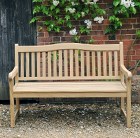New products at Crocus
by Sarah - June 6th, 2010.Filed under: Crocus, New Products.
New items today at Crocus
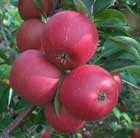
apple £29.99
Position: full sunSoil: fertile, well-drained soilRate of growth: average to fast-growingUltimate size on M27 rootstock: 1.8 x 1.8m (6 x 6ft)Ultimate size on M26 rootstock: 3 x 3m (10 x 10ft)Ultimate size on MM106 rootstock: 5.5 x 5.5m (18 x 18ft)Ultimate size Minarette on M26 rootstock: 3m x 30cm (10 x 1ft): Flowering period: April and MayHardiness: fully hardyPollination Group: C – flowering mid to late seasonThis upright, spreading tree is covered in pure white, cup-shaped flowers in mid and late spring, followed by first class, juicy dessert apples for harvesting in early to mid October. A moderately vigorous variety, which is self-fertile and produces perhaps the best British eating apple. Garden care: Keep the base of the tree weed free, fertilise at the beginning of each year and water regularly during hot, dry spells. Remove damaged or crossing branches during the dormant season.Pollination Information: This apple belongs to pollination group C, however it is self fertile, so does not need a pollinating partner to produce a bumper crop of apples. It can also be used to cross-pollinate with other apples in this group.
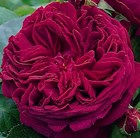
rose Falstaff (shrub) £12.99
Position: full sunSoil: fertile, humus-rich, moist, well-drained soilRate of growth: fast-growingFlowering period: June and AugustFlower colour: dark crimson/purpleOther features: excellent cut-flowersHardiness: fully hardyOne of the best crimson/purple roses bred to date. The large, cupped, double flowers have a powerful old rose fragrance. The rich, dark crimson flowers eventually turn to a lovely rich purple colour.Garden care: Before planting shorten thick roots to 25cm (10in) and reduce top-growth to an outward-facing bud 8-15cm (3-6in) above ground-level. Plant during a frost-free spell, incorporating well-rotted organic matter and a balanced fertiliser into the planting hole. Ensure that the ‘bud union’ (the bulge at the base of the shoots) is 2.5cm (1in) below the soil.All our roses are field grown. In October/November they are dug up and potted. However, they will not produce any new roots until spring, so don’t be surprised if the compost falls away from the roots when winter planting. Some suppliers send out ‘bare root’ plants unpotted, but we don’t as it is easier to manage them on the nursery in pots.
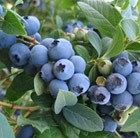
blueberry – mid-season fruiting £9.99
Position: full sun or partial shadeSoil: prefers moist, well-drained acidic soil but will grow in sandy or normal soilRate of growth: fast-growingOther features: light blue berries (July)Hardiness: fully hardyA mid-season variety which produces a heavy crop of light blue berries that are full of flavour. It is a vigorous shrub with an upright habit and has good drought resistance. Like all blueberries, it must have moist, acidic soil to flourish. Even without the added bonus of delicious berries, it does make an attractive deciduous shrub with white flowers in spring and striking autumn colours.Garden care: Prepare the ground well before planting. Blueberries can also be grown in large pots and containers if ericaceous compost is used. Prune in winter, cutting out dead or damaged branches. In spring, feed with sulphate of ammonia, sulphate of potash and bonemeal and top-dress with ericaceous compost.
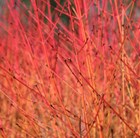
dogwood £8.99
Position: full sun to part shadeSoil: any moderately fertile soilRate of growth: fast-growingFlowering period: JuneHardiness: fully hardyThis deciduous shrub has oval, mid-green leaves and produces small, creamy-white flowers in May and June. But it’s really grown for the brilliant, flame-coloured stems that are revealed when the leaves, which turn orange-yellow in autumn, fall. This fabulous dogwood looks best planted in groups in damp areas of the garden, beside water, or in a winter border. One of our recommended plants, it’s best in full sun, and works particularly well with red or purple-stemmed varieties of dogwood.Garden care: For best stem colour, cut the stems back hard to within 5-7cm (2-3in) from the ground in March and apply a generous 5-7cm (2-3in) mulch of well-rotted garden compost or horse manure around the base of the plant.
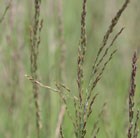
purple moor-grass £7.99
Position: full sun or partial shadeSoil: any moist but well-drained, preferably acid to neutral soilRate of growth: slow-growingFlowering period: July – SeptemberHardiness: fully hardyA graceful grass with widely arching green blades. In late summer, flowers spikes rise above the fountain-like mounds and create a lovely, airy effect – it is perfect for adding movement to the border. This is an incredibly versatile plant as it works well in mass plantings, provides a great partner to herbaceous perennials where it adds textural contrast, or it can be potted up into containers and placed on a patio.Garden care: Cut back in early spring before the new foliage appears.
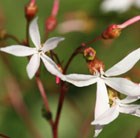
bowmans root £6.99
Position: partial shadeSoil: fertile, well-drained soil, neutral to slightly acidic soilRate of growth: averageFlowering period: JuneHardiness: fully hardyA charming perennial that bears masses of delicate, star-shaped white flowers in midsummer. In autumn, the pretty, three-leafed foliage turns fiery red and the winter seedheads are a bonus too. Lovely towards the front of a shady, woodland border, where the flowers can be appreciated.Garden care: Divide congested plants in spring or autumn. Protect young shoots from slug attack.
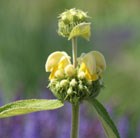
phlomis £6.99
Position: full sun Soil: any fertile, well-drained soilRate of growth: average-fast Flowering period: May to SeptemberHardiness: fully hardyFrom late spring, right through to early autumn, whorls of hooded, pale yellow flowers appear at intervals on tall, erect stems with dramatic, heart-shaped leaves. A vigorous, spreading perennial that’s justifiably popular, due to its long flowering season and tolerance of drought. It looks great in a mixed border, but it needs room to express itself. The flowers are also worth leaving on in winter as they look magical when covered in frost.Garden care: In mid-spring shorten any frost-damaged stems, cutting back to just above a healthy bud. Remove any weak or diseased shoots, cutting cleanly back to the base.
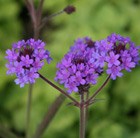
verbena £6.49
Position: full sunSoil: moderately fertile, moist, well-drained soilRate of growth: average to fast-growing Flowering period: June to September Flower colour: bright purple or magentaOther features: self-seeds freely; toothed, dark green leaves; highly attractive to butterflies and beesHardiness: frost hardy (needs winter protection)A neat, low-growing verbena producing lax clusters of fragrant, bright purple or magenta flowers from June to September. This jewel-like perennial is perfect for a sheltered, sunny, well-drained spot. Associating well with grey and silver-leaved plants, it’s wonderful used in generous drifts for infilling a traditional knot garden.Garden care: In areas prone to frost apply a deep, dry winter mulch around the crown of the plant.
burnett £5.99
common box £4.99







